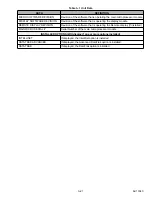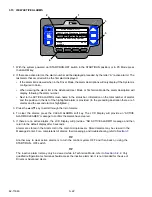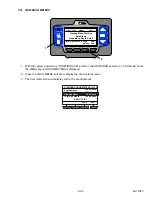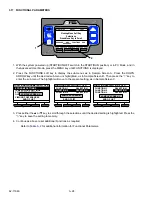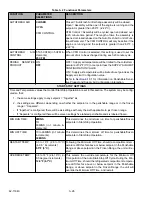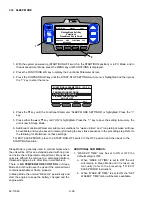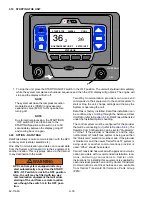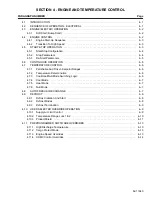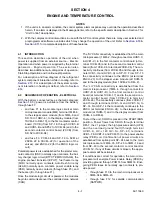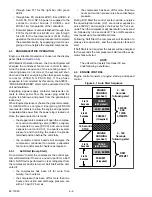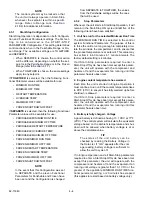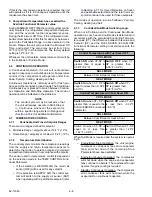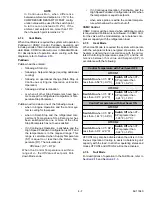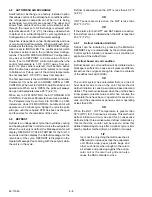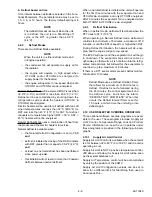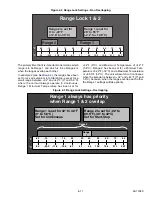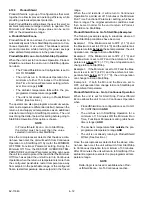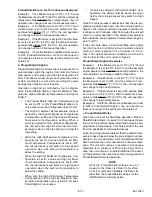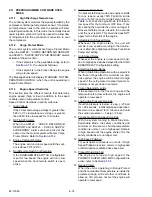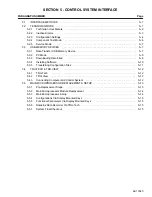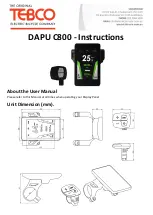
4–3
62-11640
4.4.1
Engine Start-Up Sequence
On command to perform a Start-up the main micropro-
cessor will supply power from 3MM-10 to the fuel pump
(FP) and from 3MM
−
9 to ENCU-44. This signals the
ENCU that engine operation is required. The control
system will then enter the engine start sequence. During
the start sequence the engine is operated in low speed.
Following start, the refrigeration system will then operate
in the mode(s) required for temperature control.
The engine start sequence consists of periods of time
with the engine preheater (EPH
−
power from 3MM
−
14
through PCM
−
27 to EPHT) and starter (SM
−
power
from 3MM
−
12 to SS, closing SSC contacts) energized
and de-energized for up to three start attempts (see
), the pre-heat time will vary in duration based on
engine coolant temperature (refer to
If the A00129 - “CHECK ENGINE COOLANT SEN-
SOR” alarm is active, the ambient temperature sensor
will be used. If both the A00129 - “CHECK ENGINE
COOLANT SENSOR” alarm and the A00121 - “CHECK
AMBIENT SENSOR” alarms are active the control sys-
tem assumes a temperature of less than 32°F (0°C) for
the preheat timing.
During the last five seconds of preheat OR for 5 sec-
onds before a start attempt, if no preheat is required,
the buzzer (B) is energized; then the starter solenoid
contactor (SSC) will be energized for a maximum of ten
seconds while the engine condition is checked during
the cranking period. The engine is considered to be
running, and the start sequence will be stopped, when
engine speed is greater than 1000 rpm and the engine
oil pressure switch (ENOPS) is closed.
During the second and third attempts, the control sys-
tem will monitor additional inputs.
• When engine speed reading is less than 1000
rpm, ambient temperature is above 32°F (0°C)
and the ENOPS is closed - the A00130 - “CHECK
ENGINE RPM SENSOR” alarm will be activated
and the engine will be considered running.
• When engine speed reading is less that 1000
rpm, ambient temperature is below 32°F (0°C),
the ENOPS is closed and DC current is more
than 2 amps - the A00130 - “CHECK ENGINE
RPM SENSOR” alarm will be activated and the
engine will be considered running.
Once the engine is considered running, the control sys-
tem will keep the preheater energized for an additional
0 to 180 seconds of Post Heat, depending on engine
coolant temperature (refer to
During the start sequence the control system monitors
engine speed while cranking. If engine speed drops
below 50 rpm for three seconds the starter solenoid
contactor will be de-energized and the A00035 -
“CHECK STARTER CIRCUIT” alarm will be activated.
If the unit fails to start after three start attempts, the
A00031 - “FAILED TO START-AUTO“ alarm will be
activated.
If the unit is equipped with a fuel heater, the control
system will monitor ambient temperature. If ambient is
below 77°F (25°C) the fuel heater relay (FHR) will be
energized. Energizing FHR closes its normally open
contacts to supply power from fuse F14, through the
fuel heater temperature switch (FHTS) to the heater.
Refer to
for FHTS settings.
4.4.2
Transition To High Speed
After a successful start, the control system may call for
the engine to transition to high speed. When high speed
is required, the main microprocessor will provide a sig-
nal through the CAN system to the ENCU, calling for the
speed change. Three factors control this transition.
• First: transition may be delayed if a time value is
entered in the HIGH SPEED DELAY Configura-
tion. The delay may be set to 0 to 10 minutes.
The factory default setting is 1 minute.
• Second: if the engine is started when the coolant
temperature is 79°F (26°C) or below it will
remain in low speed until the coolant tempera-
ture reaches 79°F (26°C) or it has operated for a
minimum of 15 seconds. Once the coolant tem-
perature reaches 79°F (26°C) the engine may
transition to high speed.
• Third: transition will be based on the need for tem-
perature control. Generally, the engine will oper-
ate in high speed when the unit is in Pulldown or
Pull-Up Mode (full capacity required) and in low
speed when less than full capacity is required.
4.5
START-STOP OPERATION
Start-Stop is provided to reduce fuel or power con-
sumption. This feature allows full automatic control of
the unit by monitoring compartment temperature, bat-
tery condition and (when in Engine Operation) engine
coolant temperature.
The main function of Start-Stop Operation is to shut-
down the engine or compressor after certain conditions
are met (to provide an efficient temperature control
system) and to initiate a restart sequence after certain
conditions are met. The Start-Stop/Continuous key is
pressed to select between Continuous and Start-Stop
Operation. The mode of operation will be indicated in
the status bar.
Table 4–1 Engine Preheat Time
Engine Coolant Tem-
perature
Heat Time in Seconds
Preheat
Post Heat
Less than 33°F (1.0°C)
30
180
33°F to 51°F (1.0 to 11°C)
20
120
51°F to 78°F (11 to 26°C)
10
60
Greater than 78°F (26°C)
0
0
Summary of Contents for Vector 8500
Page 23: ...62 11640 1 6 1 3 SAFETY DECALS ...
Page 24: ...1 7 62 11640 62 03958 ...
Page 25: ...62 11640 1 8 ...
Page 26: ...1 9 62 11640 ...
Page 27: ...62 11640 1 10 ...
Page 125: ...62 11640 SECTION 6 MESSAGECENTER PARAGRAPH NUMBER Page 6 1 MESSAGECENTER MESSAGES 6 1 ...
Page 321: ......
Page 322: ......

